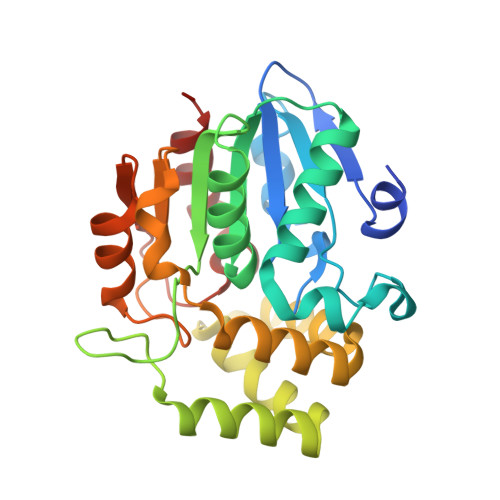Rationally Designed Strigolactone Analogs as Antagonists of the D14 Receptor.
Takeuchi, J., Jiang, K., Hirabayashi, K., Imamura, Y., Wu, Y., Xu, Y., Miyakawa, T., Nakamura, H., Tanokura, M., Asami, T.(2018) Plant Cell Physiol 59: 1545-1554
- PubMed: 29727000
- DOI: https://doi.org/10.1093/pcp/pcy087
- Primary Citation of Related Structures:
5YZ7 - PubMed Abstract:
Strigolactones (SLs) are plant hormones that inhibit shoot branching and act as signals in communications with symbiotic fungi and parasitic weeds in the rhizosphere. SL signaling is mediated by DWARF14 (D14), which is an α/β-hydrolase that cleaves SLs into an ABC tricyclic lactone and a butenolide group (i.e. D-ring). This cleavage reaction (hydrolysis and dissociation) is important for inducing the interaction between D14 and its target proteins, including D3 and D53. In this study, a hydrolysis-resistant SL analog was predicted to inhibit the activation of the D14 receptor, thereby disrupting the SL signaling pathway. To test this prediction, carba-SL compounds, in which the ether oxygen of the D-ring or the phenol ether oxygen of the SL agonist (GR24 or 4-bromo debranone) was replaced with a methylene group, were synthesized as novel D14 antagonists. Subsequent biochemical and physiological studies indicated that carba-SLs blocked the interaction between D14 and D53 by inhibiting D14 hydrolytic activity. They also suppressed the SL-induced inhibition of rice tiller outgrowths. Additionally, carba-SLs antagonized the SL response in a Striga parasitic weed species. Structural analyses revealed that the D-ring of 7'-carba-4BD was hydrolyzed by D14 but did not dissociate from the 4BD skeleton. Thus, 7'-carba-4BD functioned as an antagonist rather than an agonist. Thus, the hydrolysis of the D-ring of SLs may be insufficient for activating the receptor. This study provides data relevant to designing SL receptor antagonists.
- Faculty of Agriculture, Shizuoka University, Shizuoka, Japan.
Organizational Affiliation:

















